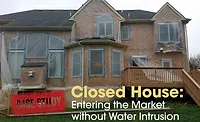It's Not Just the Heat, It's the Humidity

How to achieve the best evaporation rates is a subject of great confusion. Drying materials requires attention to a number of different variables; each of these variables has a profound influence on evaporation rates and no one variable provides the complete solution. The restoration or drying contractor must identify, consider and then address the complete project details encountered on a structural drying job in order to provide a complete and professional drying solution.
Surface Vapor Pressure
The vapor pressure of wet material is equal to a saturated vapor pressure at the temperature of the material. The higher the surface vapor pressure of the water in the material, the greater the evaporation potential.Vapor pressure is a specific humidity value, and can be measured as dew point, grains per pound of dry air (GPP) or vapor pressure in inches of Hg (mercury). Each provides an accurate numerical value, which can be used to estimate evaporation capability.
Ambient Vapor Pressure
The vapor pressure within the environment provides a vessel that will allow the evaporating water to stay in suspension. Reducing the vapor pressure in the drying area by using dehumidification systems decreases the vapor pressure content creating a vapor pressure deficit. This deficit creates a vehicle that promotes the evaporation of water, the evaporating water will work to equalize the deficit .The larger the vapor pressure differential,the greater the evaporation. This specific humidity of the ambient air can be measured as inches of (Hg), Dew point or GPP. Each provides an accurate numerical value that can be used to estimate evaporation.
The greater the differential between the vapor pressure at the surface and the ambient vapor pressure, the faster the evaporation.As the surface water evaporates, the subsurface or embedded water is pushed by the higher vapor pressure in the material to the lower controlled vapor pressure of the drying chamber and evaporated.The vapor pressure differential causes capillarity to occur, wicking moisture from the interior of the hygroscopic materials. The lower the ambient vapor pressure created by the desiccant dehumidifier(reducing specific humidity & raising ambient temperature), the greater the net force driving the embedded water to the surface to evaporate. This is known as “Daltons Law of Partial Pressures.”
The Surface Area of Wet Material
Calculation of surface area affected by the water damage can provide good insight into the quantity of water vapor that will evaporate. This formula quantifies the water vapor that can evaporate in a given environment.

Evaporative Cooling Effect
As water evaporates there is a net latent cooling effect of 1,060 BTUH per pound of water evaporated 1,060 BTUH is exchanged for each pound of liquid water which evaporates at normal or standard temperature (70° F) and pressure at sea level (29.96 “Hg).
To overcome this evaporative cooling, heat energy needs to be replaced, or the residual water will cool and the evaporation process will slow. By replacing the heat energy lost through evaporation, the expedited evaporation process can continue. Heat energy can be added as a byproduct of desiccant dehumidification. Additional energy can also be applied with supplemental heating systems.
The Temperature of the Drying Chamber
Evaporating water has a cooling effect on the remaining mass of water and the material. As water evaporates there is a net latent cooling effect of 1060 BTUH per pound of water evaporated.Heat energy can be used to offset the evaporative cooling effect. Heat energy can also be used to increase the temperature of the materials and the water in the material. Heat energy can be added by using a desiccant dehumidifier to control vapor pressure and a supplemental heating system to further elevate temperature if required.
Vapor pressure must be closely monitored to prevent secondary damage that occurs as the water vapor condenses on surfaces chilled through exposure to the cold outdoors or surfaces that are difficult to heat. Ventilating the house with outdoor air does not necessarily reduce the internal ambient vapor pressure. Most structures are insulated, and insulation by design resists heat flow. Structures also often have combined materials and interstitial spaces. Multiple layers, such as two or more layers of drywall, built-up flooring or roof systems, resist heat flow by design. It is time consuming, energy intensive and expensive to add heat energy to a concrete slab or a multilayer wall system with hot air.
Multilayered materials also adsorb water and or heat at different rates. While heat can be helpful to the drying contractor, water vapor evaporates based on differential vapor pressure. If there is a cool exterior wall and a high vapor pressure indoors, the force of the vapor pressure deficit will compel the water vapor through the wall system and cause condensation inside the wall on the cold surfaces.
Airflow across the Wet Surface
Evaporating water creates a boundary layer between the wet surface and the low vapor pressure air. To reduce the dimension of the boundary layer between evaporating water and the dry low vapor pressure environment, air must be directed with velocity across or directly at the wet surface. This forces the low vapor pressure air into direct contact with the higher surface vapor pressure of the wet material, allowing more rapid transfer of water vapor. This air can also be used to transfer offsetting heat energy to compensate for the evaporative cooling effect. The airflow velocity will assist the evaporation effort as discussed in “Evaporation into the Atmosphere: Theory, History, and Applications” - Wilfried Brutsaert – 1934.
Evaporation Rate = fd(u)(Es-Ea)
fd(u) - function of the mean wind speed (u)
Es - saturation vapor pressure at the surface
Ea - vapor pressure in the air
This formula is now used to estimate evaporation potential of oceans and lakes. The same science applies to the drying chamber.
Dew point Temperature of the Attic and or Exterior Walls
Mechanical Dehumidification of enclosed spaces is used to create a low ambient vapor pressure to facilitate the evaporation of water from wet materials. If this accumulated vapor pressure is not controlled, it can collect on or adjacent to cool surfaces where it nears dew point and cause condensation. This can result concealed water damage in attics, wall areas or other areas where the air reaches dew point. The restoration contractor must be aware of this potential issue and consider dew points within the structure so as to guard against secondary damage.
There is a significant risk associated with the use of supplemental heating systems with a disregard to the potential increase of vapor pressure of the built environment. Simply providing heat to a structure does not change the ambient vapor pressure and the associated internal or interstitial dew points. The heat must be absorbed by the materials and the water in the materials to influence the drying rate. The heat must actually “cook” the water in the house to start the evaporation process. Once the water is evaporated it is important to control the internal dew point to avoid secondary damage.
Surface or Site Contamination
In all cases, surface contamination or contaminated water can affect the rate of evaporation. Oils and other materials can coat the surface of the water and effectively isolate the water from the low vapor pressure air and hinder or eliminate evaporation. The Hoffen and Mullen research paper of 1970 tested water droplets in a wind tunnel to determine evaporation rates with contaminants, they state that the droplet evaporation rate slows with surface contamination.

To size dehumidification equipment for a project, the equipment circulation capacity in generally listed in Standard Cubic Feet of air per Minute, (SCFM). The total volume of the area to be dried is considered when sizing dehumidifiers to effectively control vapor pressure. A 60’ L x 40’ W x 15’ H area contains 36,000 Cubic Feet. The initial recommendation from IICRC is 1 to 3 air exchanges per hour, requiring 600 SCFM to 1,800 SCFM of desiccant based dehumidification. A number of factors might require additional capacity depending on specific job conditions. We must consider exterior influences. The 1 to 3 air exchanges might be enough to gain preliminary control of the ambient environment; to provide the best vapor pressure deficit in the ambient, additional equipment might be required. Monitoring the environment will provide accurate data for the restoration professional.
External Influences
Infiltration of water vapor into a controlled low humidity environment is related to the outside conditions and the integrity of the structure. Windows, doors, cracks, HVAC systems all add potential for moisture infiltration. Creating a low humidity environment in a structure creates a vapor pressure deficit. Higher vapor pressure will cause vapor movement through walls and structure. The vapor movement will attempt to equalize the deficit. Any windows, doors cracks or gaps will allow water vapor to penetrate the controlled environment. Leaks and gaps can require additional dehumidification equipment to adequately control the increased moisture loads. Water Vapor leaking into the built environment must be compensated for to produce optimum results.
Water damage contractors have different types of equipment available to dry structures. There is no single solution to every water loss. All projects will usually require multiple technologies to effectively control vapor pressure differentials. Refrigeration will reduce vapor pressure, but is limited by the surface coil temperature for capacity. Heating energy will not reduce vapor pressure but can eventually add heat energy to the structure and residual water in the structure. Complex materials and substrates have significant mass, which can be very slow to absorb additional energy; providing only heat does not necessarily provide an increase in the surface vapor pressure or an increase in evaporation rates.
The water damage contractor has to control the net vapor pressure differential to effectively dry structures and materials. Desiccants are one of the technologies that will provide a vapor pressure differential and heat. Desiccants can also be combined effectively with other system to peak the performance.
Looking for a reprint of this article?
From high-res PDFs to custom plaques, order your copy today!








